Implementing Operations Management Principles at Toyota: A Report
VerifiedAdded on 2023/01/19
|28
|8611
|90
Report
AI Summary
This report provides a comprehensive analysis of operations and project management within Toyota Motor Corporation. It begins with an introduction to operations management and its significance, followed by a critical review of the implementation of operations management principles within Toyota's organizational context. The report then develops a continuous improvement plan, incorporating frameworks like the PDCA cycle and Kaizen, and analyzes the effectiveness of this plan, supported by models like Six Sigma. Furthermore, the report applies the stages of the project life cycle to a given project, including the production of necessary documentation and an analysis of project methodologies, tools, and leadership within the project life cycle. The report also evaluates methods of performance measurement and concludes with a summary of findings and recommendations, referencing key academic sources throughout.
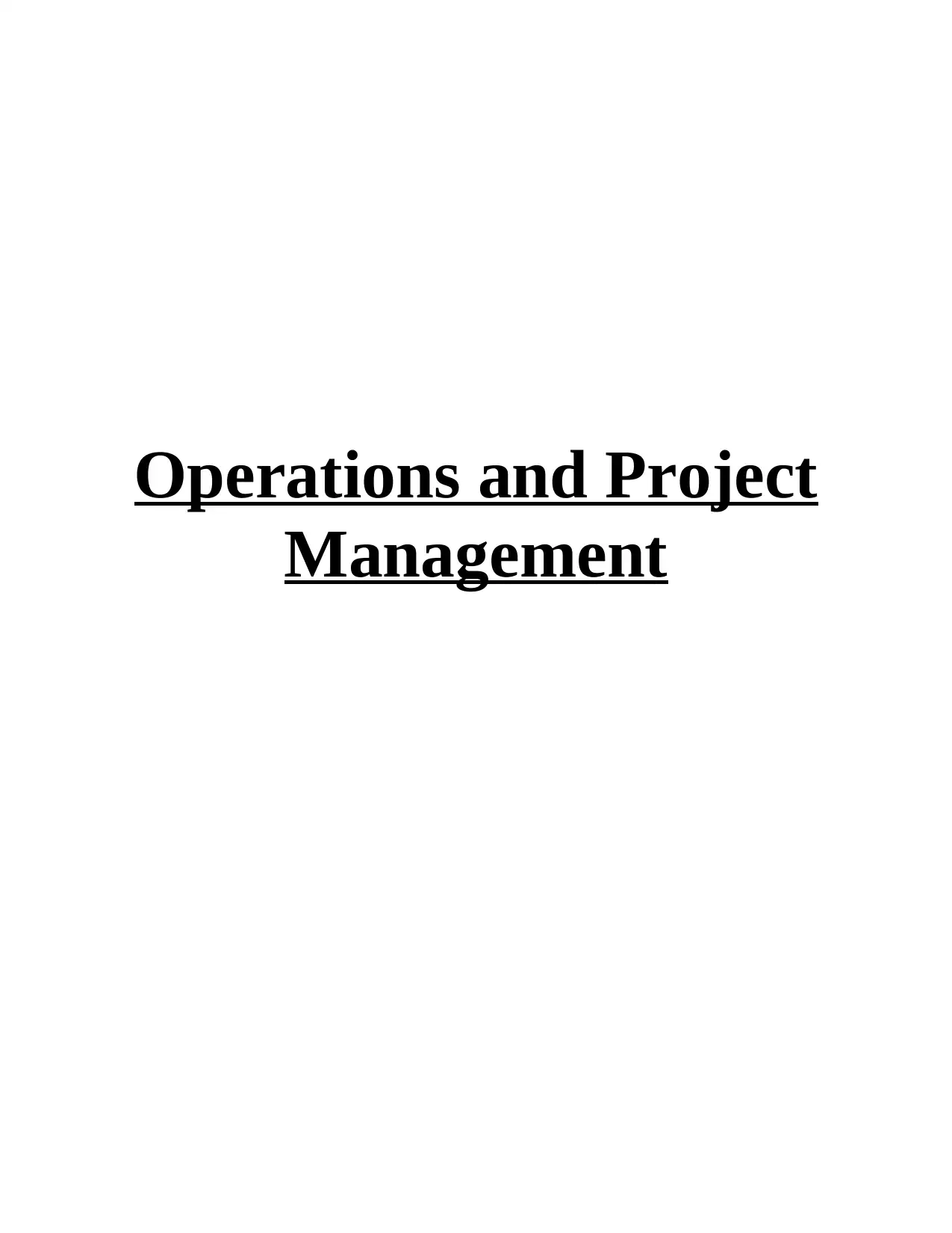
Operations and Project
Management
Management
Paraphrase This Document
Need a fresh take? Get an instant paraphrase of this document with our AI Paraphraser
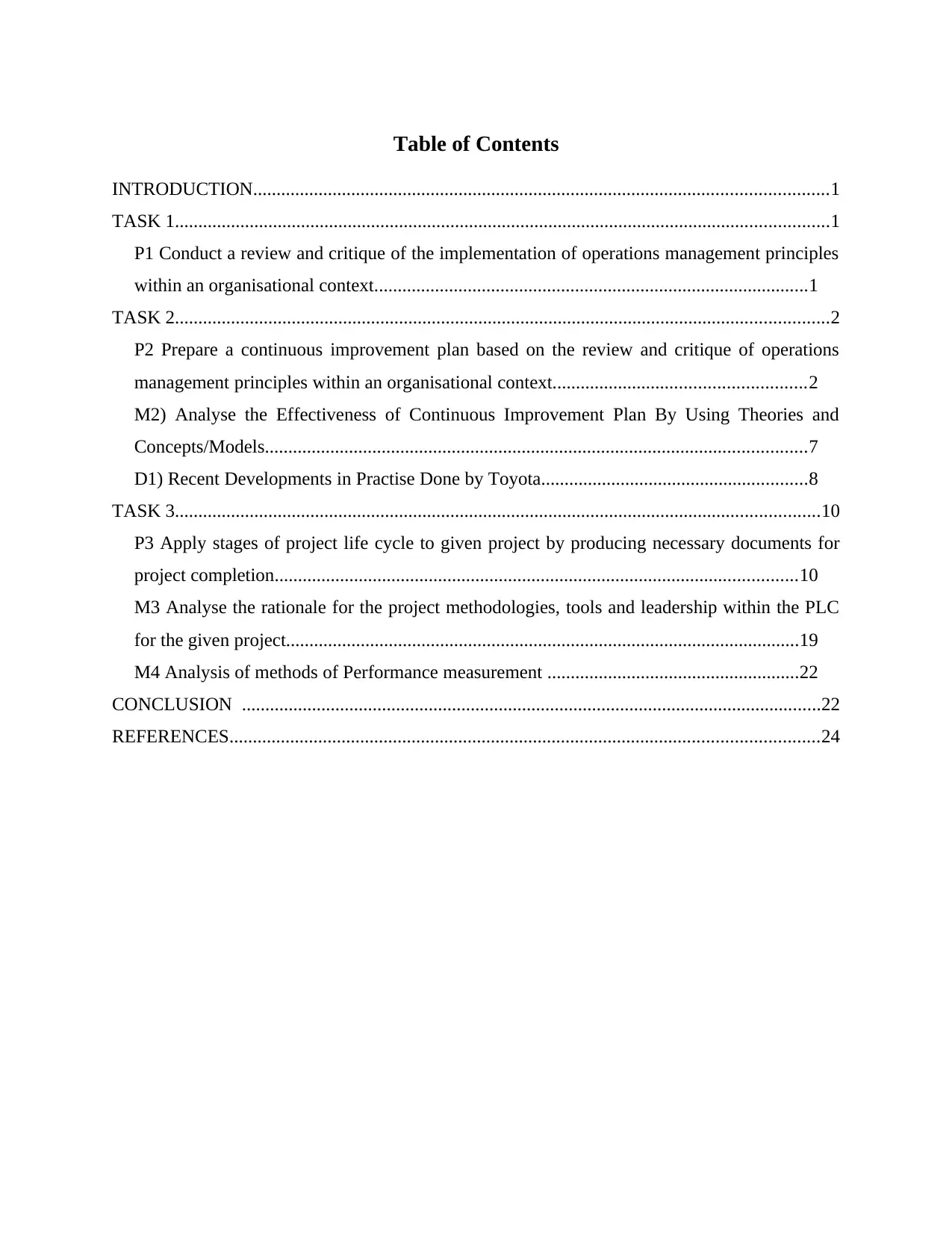
Table of Contents
INTRODUCTION...........................................................................................................................1
TASK 1............................................................................................................................................1
P1 Conduct a review and critique of the implementation of operations management principles
within an organisational context.............................................................................................1
TASK 2............................................................................................................................................2
P2 Prepare a continuous improvement plan based on the review and critique of operations
management principles within an organisational context......................................................2
M2) Analyse the Effectiveness of Continuous Improvement Plan By Using Theories and
Concepts/Models....................................................................................................................7
D1) Recent Developments in Practise Done by Toyota.........................................................8
TASK 3..........................................................................................................................................10
P3 Apply stages of project life cycle to given project by producing necessary documents for
project completion................................................................................................................10
M3 Analyse the rationale for the project methodologies, tools and leadership within the PLC
for the given project..............................................................................................................19
M4 Analysis of methods of Performance measurement ......................................................22
CONCLUSION ............................................................................................................................22
REFERENCES..............................................................................................................................24
INTRODUCTION...........................................................................................................................1
TASK 1............................................................................................................................................1
P1 Conduct a review and critique of the implementation of operations management principles
within an organisational context.............................................................................................1
TASK 2............................................................................................................................................2
P2 Prepare a continuous improvement plan based on the review and critique of operations
management principles within an organisational context......................................................2
M2) Analyse the Effectiveness of Continuous Improvement Plan By Using Theories and
Concepts/Models....................................................................................................................7
D1) Recent Developments in Practise Done by Toyota.........................................................8
TASK 3..........................................................................................................................................10
P3 Apply stages of project life cycle to given project by producing necessary documents for
project completion................................................................................................................10
M3 Analyse the rationale for the project methodologies, tools and leadership within the PLC
for the given project..............................................................................................................19
M4 Analysis of methods of Performance measurement ......................................................22
CONCLUSION ............................................................................................................................22
REFERENCES..............................................................................................................................24
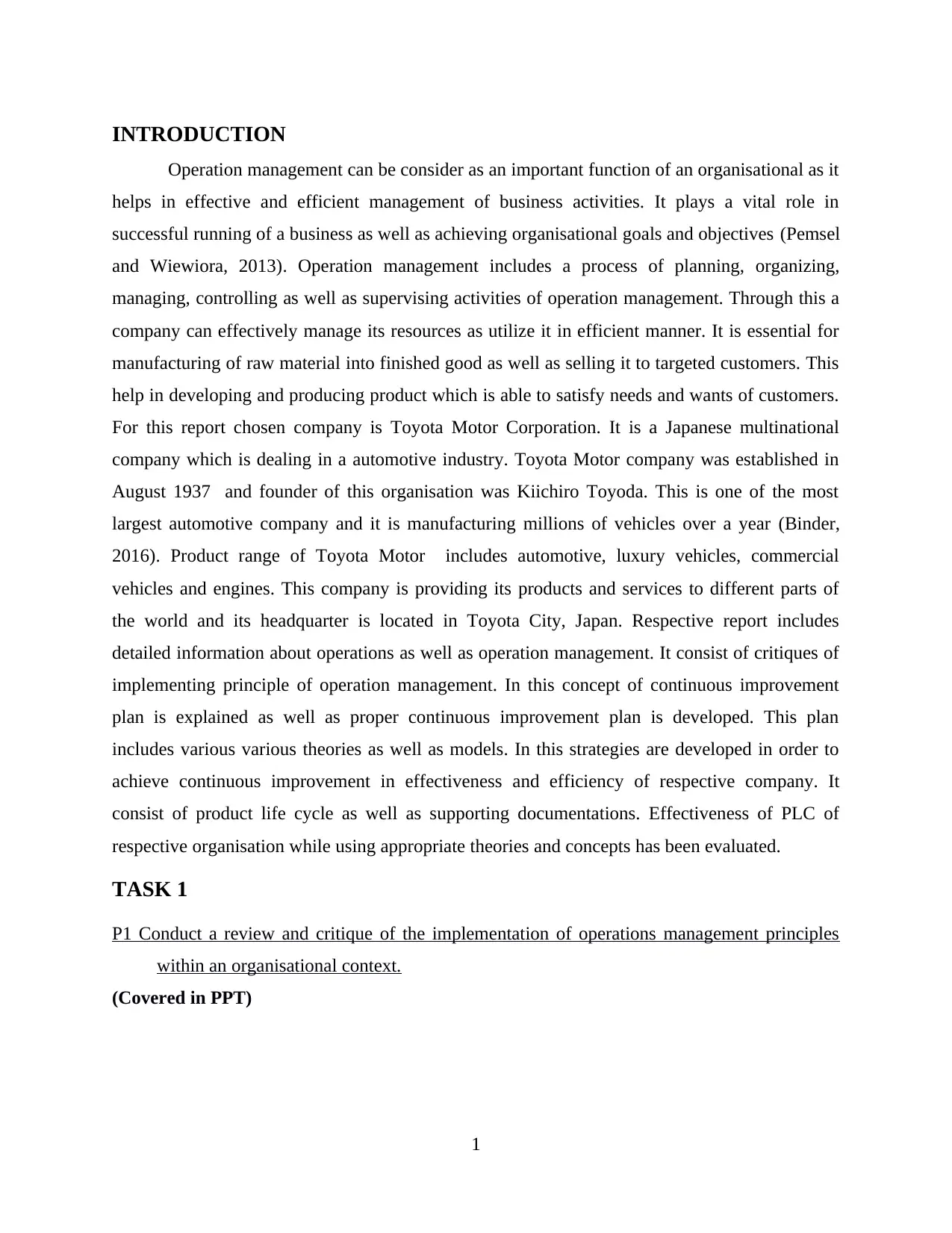
INTRODUCTION
Operation management can be consider as an important function of an organisational as it
helps in effective and efficient management of business activities. It plays a vital role in
successful running of a business as well as achieving organisational goals and objectives (Pemsel
and Wiewiora, 2013). Operation management includes a process of planning, organizing,
managing, controlling as well as supervising activities of operation management. Through this a
company can effectively manage its resources as utilize it in efficient manner. It is essential for
manufacturing of raw material into finished good as well as selling it to targeted customers. This
help in developing and producing product which is able to satisfy needs and wants of customers.
For this report chosen company is Toyota Motor Corporation. It is a Japanese multinational
company which is dealing in a automotive industry. Toyota Motor company was established in
August 1937 and founder of this organisation was Kiichiro Toyoda. This is one of the most
largest automotive company and it is manufacturing millions of vehicles over a year (Binder,
2016). Product range of Toyota Motor includes automotive, luxury vehicles, commercial
vehicles and engines. This company is providing its products and services to different parts of
the world and its headquarter is located in Toyota City, Japan. Respective report includes
detailed information about operations as well as operation management. It consist of critiques of
implementing principle of operation management. In this concept of continuous improvement
plan is explained as well as proper continuous improvement plan is developed. This plan
includes various various theories as well as models. In this strategies are developed in order to
achieve continuous improvement in effectiveness and efficiency of respective company. It
consist of product life cycle as well as supporting documentations. Effectiveness of PLC of
respective organisation while using appropriate theories and concepts has been evaluated.
TASK 1
P1 Conduct a review and critique of the implementation of operations management principles
within an organisational context.
(Covered in PPT)
1
Operation management can be consider as an important function of an organisational as it
helps in effective and efficient management of business activities. It plays a vital role in
successful running of a business as well as achieving organisational goals and objectives (Pemsel
and Wiewiora, 2013). Operation management includes a process of planning, organizing,
managing, controlling as well as supervising activities of operation management. Through this a
company can effectively manage its resources as utilize it in efficient manner. It is essential for
manufacturing of raw material into finished good as well as selling it to targeted customers. This
help in developing and producing product which is able to satisfy needs and wants of customers.
For this report chosen company is Toyota Motor Corporation. It is a Japanese multinational
company which is dealing in a automotive industry. Toyota Motor company was established in
August 1937 and founder of this organisation was Kiichiro Toyoda. This is one of the most
largest automotive company and it is manufacturing millions of vehicles over a year (Binder,
2016). Product range of Toyota Motor includes automotive, luxury vehicles, commercial
vehicles and engines. This company is providing its products and services to different parts of
the world and its headquarter is located in Toyota City, Japan. Respective report includes
detailed information about operations as well as operation management. It consist of critiques of
implementing principle of operation management. In this concept of continuous improvement
plan is explained as well as proper continuous improvement plan is developed. This plan
includes various various theories as well as models. In this strategies are developed in order to
achieve continuous improvement in effectiveness and efficiency of respective company. It
consist of product life cycle as well as supporting documentations. Effectiveness of PLC of
respective organisation while using appropriate theories and concepts has been evaluated.
TASK 1
P1 Conduct a review and critique of the implementation of operations management principles
within an organisational context.
(Covered in PPT)
1
⊘ This is a preview!⊘
Do you want full access?
Subscribe today to unlock all pages.

Trusted by 1+ million students worldwide
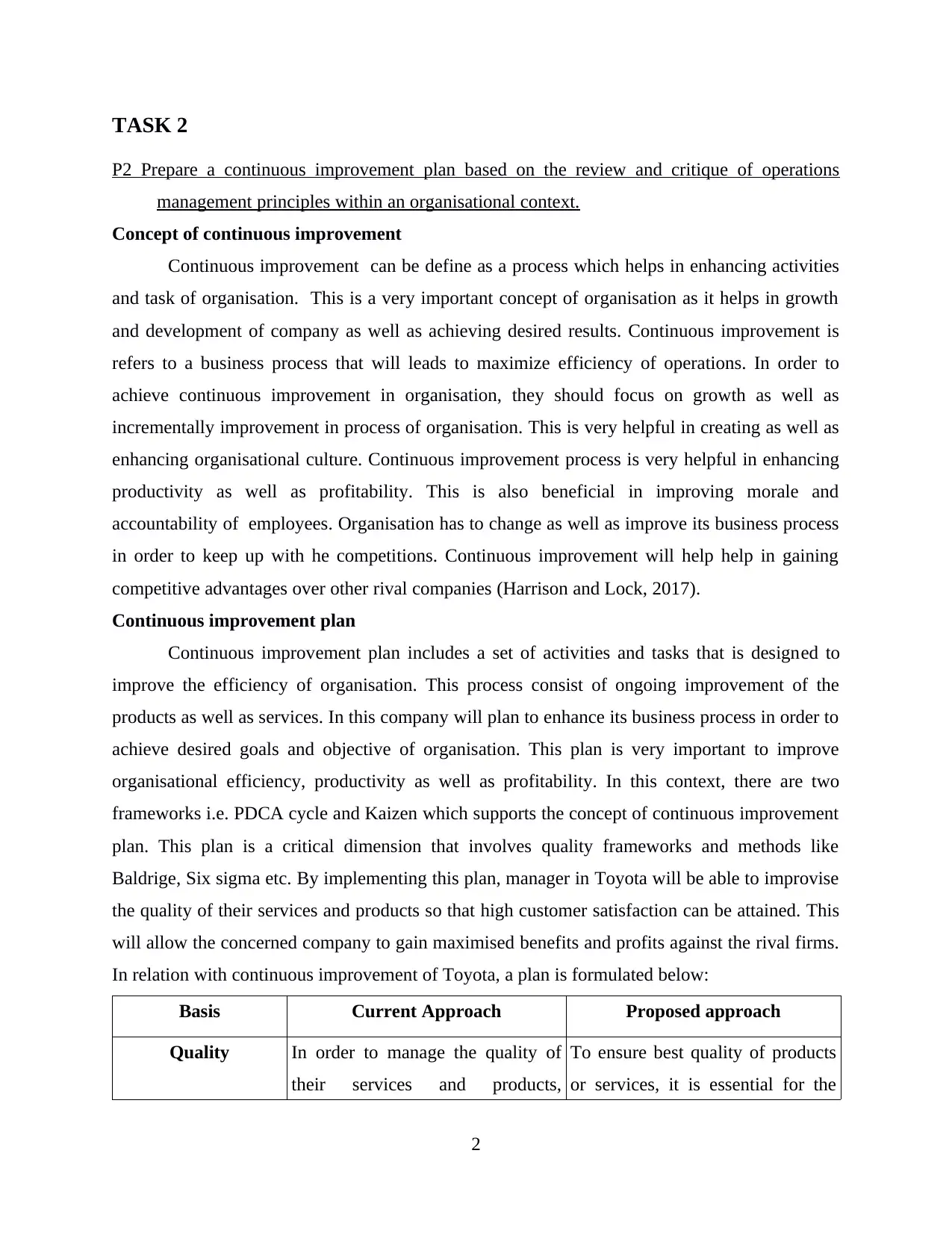
TASK 2
P2 Prepare a continuous improvement plan based on the review and critique of operations
management principles within an organisational context.
Concept of continuous improvement
Continuous improvement can be define as a process which helps in enhancing activities
and task of organisation. This is a very important concept of organisation as it helps in growth
and development of company as well as achieving desired results. Continuous improvement is
refers to a business process that will leads to maximize efficiency of operations. In order to
achieve continuous improvement in organisation, they should focus on growth as well as
incrementally improvement in process of organisation. This is very helpful in creating as well as
enhancing organisational culture. Continuous improvement process is very helpful in enhancing
productivity as well as profitability. This is also beneficial in improving morale and
accountability of employees. Organisation has to change as well as improve its business process
in order to keep up with he competitions. Continuous improvement will help help in gaining
competitive advantages over other rival companies (Harrison and Lock, 2017).
Continuous improvement plan
Continuous improvement plan includes a set of activities and tasks that is designed to
improve the efficiency of organisation. This process consist of ongoing improvement of the
products as well as services. In this company will plan to enhance its business process in order to
achieve desired goals and objective of organisation. This plan is very important to improve
organisational efficiency, productivity as well as profitability. In this context, there are two
frameworks i.e. PDCA cycle and Kaizen which supports the concept of continuous improvement
plan. This plan is a critical dimension that involves quality frameworks and methods like
Baldrige, Six sigma etc. By implementing this plan, manager in Toyota will be able to improvise
the quality of their services and products so that high customer satisfaction can be attained. This
will allow the concerned company to gain maximised benefits and profits against the rival firms.
In relation with continuous improvement of Toyota, a plan is formulated below:
Basis Current Approach Proposed approach
Quality In order to manage the quality of
their services and products,
To ensure best quality of products
or services, it is essential for the
2
P2 Prepare a continuous improvement plan based on the review and critique of operations
management principles within an organisational context.
Concept of continuous improvement
Continuous improvement can be define as a process which helps in enhancing activities
and task of organisation. This is a very important concept of organisation as it helps in growth
and development of company as well as achieving desired results. Continuous improvement is
refers to a business process that will leads to maximize efficiency of operations. In order to
achieve continuous improvement in organisation, they should focus on growth as well as
incrementally improvement in process of organisation. This is very helpful in creating as well as
enhancing organisational culture. Continuous improvement process is very helpful in enhancing
productivity as well as profitability. This is also beneficial in improving morale and
accountability of employees. Organisation has to change as well as improve its business process
in order to keep up with he competitions. Continuous improvement will help help in gaining
competitive advantages over other rival companies (Harrison and Lock, 2017).
Continuous improvement plan
Continuous improvement plan includes a set of activities and tasks that is designed to
improve the efficiency of organisation. This process consist of ongoing improvement of the
products as well as services. In this company will plan to enhance its business process in order to
achieve desired goals and objective of organisation. This plan is very important to improve
organisational efficiency, productivity as well as profitability. In this context, there are two
frameworks i.e. PDCA cycle and Kaizen which supports the concept of continuous improvement
plan. This plan is a critical dimension that involves quality frameworks and methods like
Baldrige, Six sigma etc. By implementing this plan, manager in Toyota will be able to improvise
the quality of their services and products so that high customer satisfaction can be attained. This
will allow the concerned company to gain maximised benefits and profits against the rival firms.
In relation with continuous improvement of Toyota, a plan is formulated below:
Basis Current Approach Proposed approach
Quality In order to manage the quality of
their services and products,
To ensure best quality of products
or services, it is essential for the
2
Paraphrase This Document
Need a fresh take? Get an instant paraphrase of this document with our AI Paraphraser
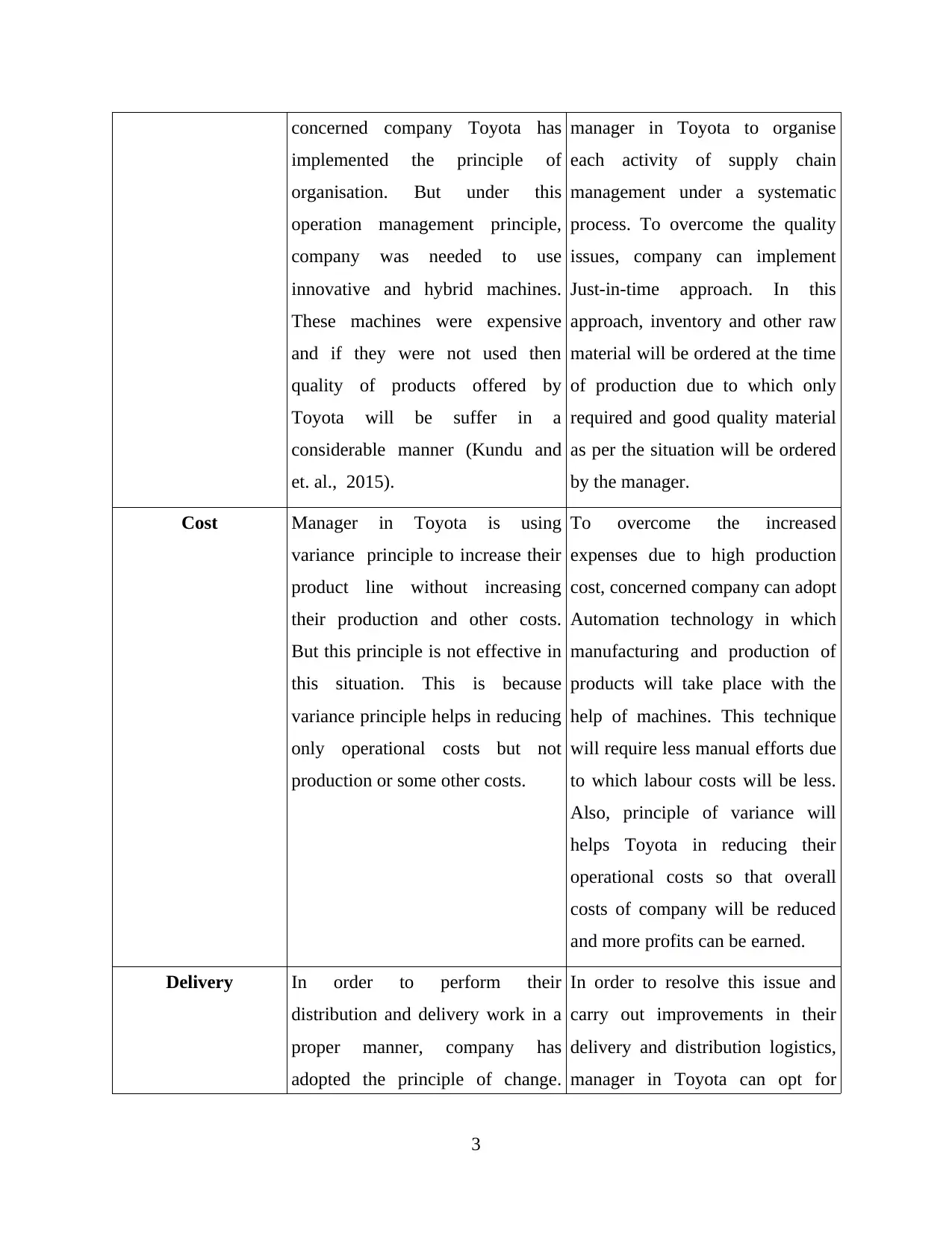
concerned company Toyota has
implemented the principle of
organisation. But under this
operation management principle,
company was needed to use
innovative and hybrid machines.
These machines were expensive
and if they were not used then
quality of products offered by
Toyota will be suffer in a
considerable manner (Kundu and
et. al., 2015).
manager in Toyota to organise
each activity of supply chain
management under a systematic
process. To overcome the quality
issues, company can implement
Just-in-time approach. In this
approach, inventory and other raw
material will be ordered at the time
of production due to which only
required and good quality material
as per the situation will be ordered
by the manager.
Cost Manager in Toyota is using
variance principle to increase their
product line without increasing
their production and other costs.
But this principle is not effective in
this situation. This is because
variance principle helps in reducing
only operational costs but not
production or some other costs.
To overcome the increased
expenses due to high production
cost, concerned company can adopt
Automation technology in which
manufacturing and production of
products will take place with the
help of machines. This technique
will require less manual efforts due
to which labour costs will be less.
Also, principle of variance will
helps Toyota in reducing their
operational costs so that overall
costs of company will be reduced
and more profits can be earned.
Delivery In order to perform their
distribution and delivery work in a
proper manner, company has
adopted the principle of change.
In order to resolve this issue and
carry out improvements in their
delivery and distribution logistics,
manager in Toyota can opt for
3
implemented the principle of
organisation. But under this
operation management principle,
company was needed to use
innovative and hybrid machines.
These machines were expensive
and if they were not used then
quality of products offered by
Toyota will be suffer in a
considerable manner (Kundu and
et. al., 2015).
manager in Toyota to organise
each activity of supply chain
management under a systematic
process. To overcome the quality
issues, company can implement
Just-in-time approach. In this
approach, inventory and other raw
material will be ordered at the time
of production due to which only
required and good quality material
as per the situation will be ordered
by the manager.
Cost Manager in Toyota is using
variance principle to increase their
product line without increasing
their production and other costs.
But this principle is not effective in
this situation. This is because
variance principle helps in reducing
only operational costs but not
production or some other costs.
To overcome the increased
expenses due to high production
cost, concerned company can adopt
Automation technology in which
manufacturing and production of
products will take place with the
help of machines. This technique
will require less manual efforts due
to which labour costs will be less.
Also, principle of variance will
helps Toyota in reducing their
operational costs so that overall
costs of company will be reduced
and more profits can be earned.
Delivery In order to perform their
distribution and delivery work in a
proper manner, company has
adopted the principle of change.
In order to resolve this issue and
carry out improvements in their
delivery and distribution logistics,
manager in Toyota can opt for
3
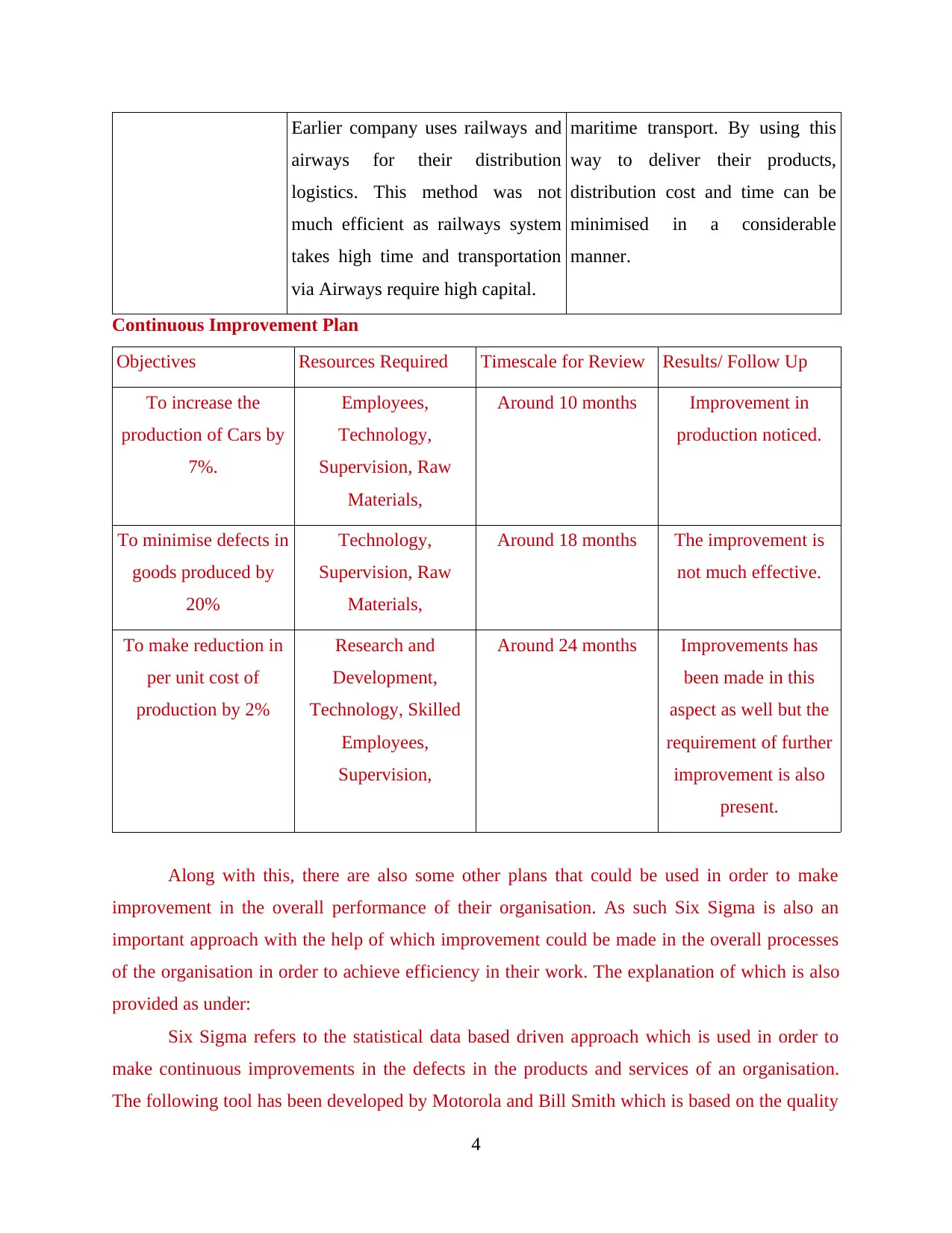
Earlier company uses railways and
airways for their distribution
logistics. This method was not
much efficient as railways system
takes high time and transportation
via Airways require high capital.
maritime transport. By using this
way to deliver their products,
distribution cost and time can be
minimised in a considerable
manner.
Continuous Improvement Plan
Objectives Resources Required Timescale for Review Results/ Follow Up
To increase the
production of Cars by
7%.
Employees,
Technology,
Supervision, Raw
Materials,
Around 10 months Improvement in
production noticed.
To minimise defects in
goods produced by
20%
Technology,
Supervision, Raw
Materials,
Around 18 months The improvement is
not much effective.
To make reduction in
per unit cost of
production by 2%
Research and
Development,
Technology, Skilled
Employees,
Supervision,
Around 24 months Improvements has
been made in this
aspect as well but the
requirement of further
improvement is also
present.
Along with this, there are also some other plans that could be used in order to make
improvement in the overall performance of their organisation. As such Six Sigma is also an
important approach with the help of which improvement could be made in the overall processes
of the organisation in order to achieve efficiency in their work. The explanation of which is also
provided as under:
Six Sigma refers to the statistical data based driven approach which is used in order to
make continuous improvements in the defects in the products and services of an organisation.
The following tool has been developed by Motorola and Bill Smith which is based on the quality
4
airways for their distribution
logistics. This method was not
much efficient as railways system
takes high time and transportation
via Airways require high capital.
maritime transport. By using this
way to deliver their products,
distribution cost and time can be
minimised in a considerable
manner.
Continuous Improvement Plan
Objectives Resources Required Timescale for Review Results/ Follow Up
To increase the
production of Cars by
7%.
Employees,
Technology,
Supervision, Raw
Materials,
Around 10 months Improvement in
production noticed.
To minimise defects in
goods produced by
20%
Technology,
Supervision, Raw
Materials,
Around 18 months The improvement is
not much effective.
To make reduction in
per unit cost of
production by 2%
Research and
Development,
Technology, Skilled
Employees,
Supervision,
Around 24 months Improvements has
been made in this
aspect as well but the
requirement of further
improvement is also
present.
Along with this, there are also some other plans that could be used in order to make
improvement in the overall performance of their organisation. As such Six Sigma is also an
important approach with the help of which improvement could be made in the overall processes
of the organisation in order to achieve efficiency in their work. The explanation of which is also
provided as under:
Six Sigma refers to the statistical data based driven approach which is used in order to
make continuous improvements in the defects in the products and services of an organisation.
The following tool has been developed by Motorola and Bill Smith which is based on the quality
4
⊘ This is a preview!⊘
Do you want full access?
Subscribe today to unlock all pages.

Trusted by 1+ million students worldwide
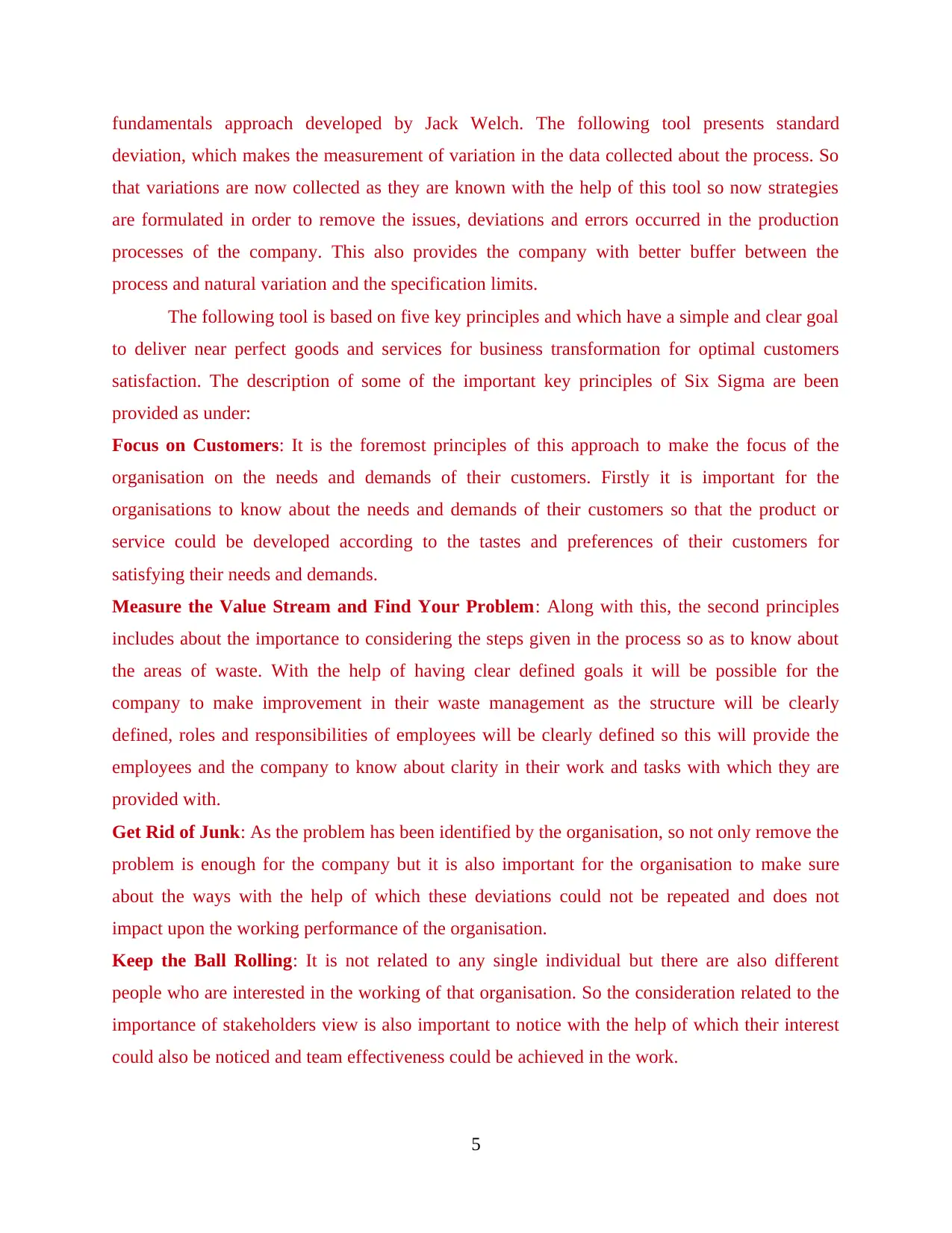
fundamentals approach developed by Jack Welch. The following tool presents standard
deviation, which makes the measurement of variation in the data collected about the process. So
that variations are now collected as they are known with the help of this tool so now strategies
are formulated in order to remove the issues, deviations and errors occurred in the production
processes of the company. This also provides the company with better buffer between the
process and natural variation and the specification limits.
The following tool is based on five key principles and which have a simple and clear goal
to deliver near perfect goods and services for business transformation for optimal customers
satisfaction. The description of some of the important key principles of Six Sigma are been
provided as under:
Focus on Customers: It is the foremost principles of this approach to make the focus of the
organisation on the needs and demands of their customers. Firstly it is important for the
organisations to know about the needs and demands of their customers so that the product or
service could be developed according to the tastes and preferences of their customers for
satisfying their needs and demands.
Measure the Value Stream and Find Your Problem: Along with this, the second principles
includes about the importance to considering the steps given in the process so as to know about
the areas of waste. With the help of having clear defined goals it will be possible for the
company to make improvement in their waste management as the structure will be clearly
defined, roles and responsibilities of employees will be clearly defined so this will provide the
employees and the company to know about clarity in their work and tasks with which they are
provided with.
Get Rid of Junk: As the problem has been identified by the organisation, so not only remove the
problem is enough for the company but it is also important for the organisation to make sure
about the ways with the help of which these deviations could not be repeated and does not
impact upon the working performance of the organisation.
Keep the Ball Rolling: It is not related to any single individual but there are also different
people who are interested in the working of that organisation. So the consideration related to the
importance of stakeholders view is also important to notice with the help of which their interest
could also be noticed and team effectiveness could be achieved in the work.
5
deviation, which makes the measurement of variation in the data collected about the process. So
that variations are now collected as they are known with the help of this tool so now strategies
are formulated in order to remove the issues, deviations and errors occurred in the production
processes of the company. This also provides the company with better buffer between the
process and natural variation and the specification limits.
The following tool is based on five key principles and which have a simple and clear goal
to deliver near perfect goods and services for business transformation for optimal customers
satisfaction. The description of some of the important key principles of Six Sigma are been
provided as under:
Focus on Customers: It is the foremost principles of this approach to make the focus of the
organisation on the needs and demands of their customers. Firstly it is important for the
organisations to know about the needs and demands of their customers so that the product or
service could be developed according to the tastes and preferences of their customers for
satisfying their needs and demands.
Measure the Value Stream and Find Your Problem: Along with this, the second principles
includes about the importance to considering the steps given in the process so as to know about
the areas of waste. With the help of having clear defined goals it will be possible for the
company to make improvement in their waste management as the structure will be clearly
defined, roles and responsibilities of employees will be clearly defined so this will provide the
employees and the company to know about clarity in their work and tasks with which they are
provided with.
Get Rid of Junk: As the problem has been identified by the organisation, so not only remove the
problem is enough for the company but it is also important for the organisation to make sure
about the ways with the help of which these deviations could not be repeated and does not
impact upon the working performance of the organisation.
Keep the Ball Rolling: It is not related to any single individual but there are also different
people who are interested in the working of that organisation. So the consideration related to the
importance of stakeholders view is also important to notice with the help of which their interest
could also be noticed and team effectiveness could be achieved in the work.
5
Paraphrase This Document
Need a fresh take? Get an instant paraphrase of this document with our AI Paraphraser
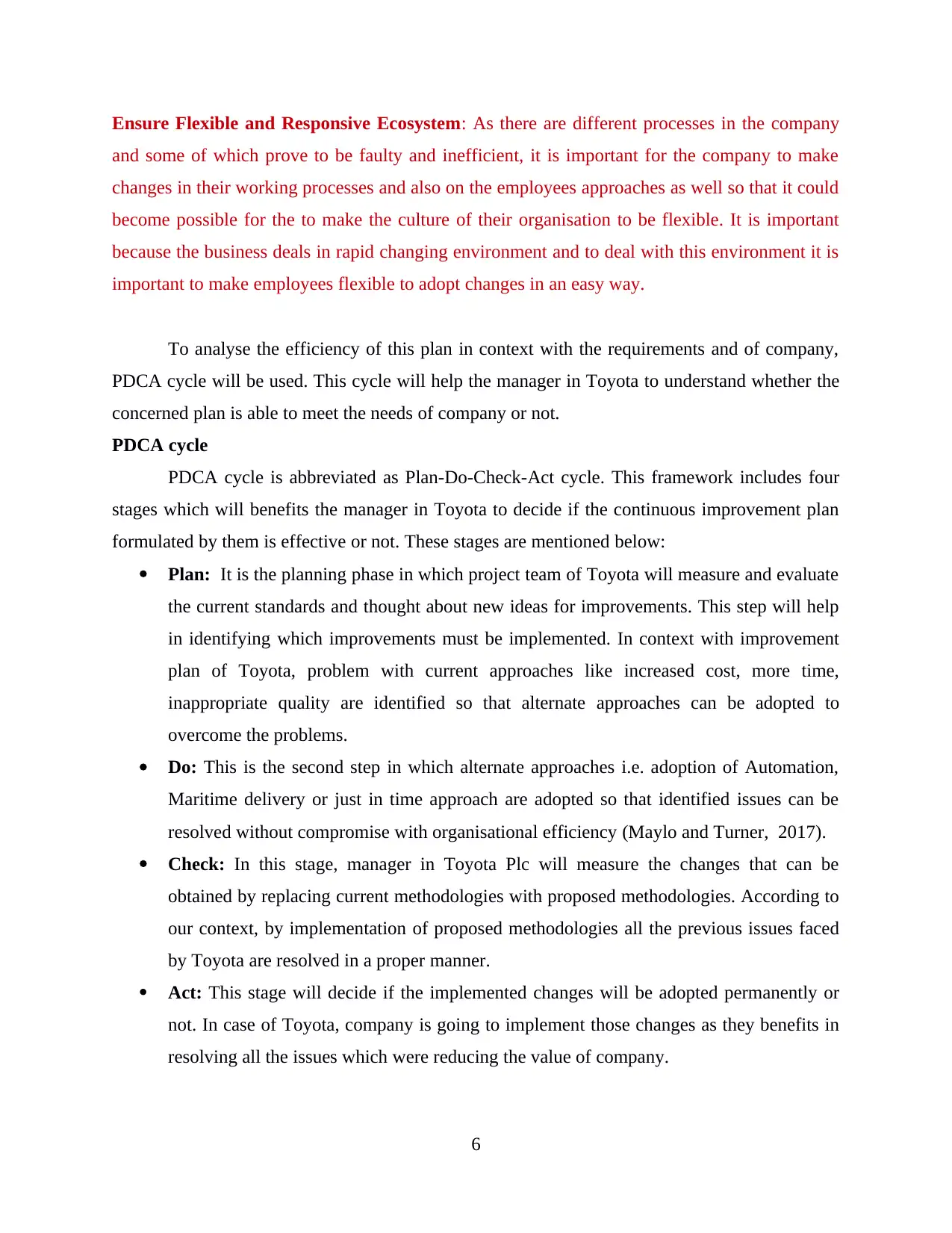
Ensure Flexible and Responsive Ecosystem: As there are different processes in the company
and some of which prove to be faulty and inefficient, it is important for the company to make
changes in their working processes and also on the employees approaches as well so that it could
become possible for the to make the culture of their organisation to be flexible. It is important
because the business deals in rapid changing environment and to deal with this environment it is
important to make employees flexible to adopt changes in an easy way.
To analyse the efficiency of this plan in context with the requirements and of company,
PDCA cycle will be used. This cycle will help the manager in Toyota to understand whether the
concerned plan is able to meet the needs of company or not.
PDCA cycle
PDCA cycle is abbreviated as Plan-Do-Check-Act cycle. This framework includes four
stages which will benefits the manager in Toyota to decide if the continuous improvement plan
formulated by them is effective or not. These stages are mentioned below:
Plan: It is the planning phase in which project team of Toyota will measure and evaluate
the current standards and thought about new ideas for improvements. This step will help
in identifying which improvements must be implemented. In context with improvement
plan of Toyota, problem with current approaches like increased cost, more time,
inappropriate quality are identified so that alternate approaches can be adopted to
overcome the problems.
Do: This is the second step in which alternate approaches i.e. adoption of Automation,
Maritime delivery or just in time approach are adopted so that identified issues can be
resolved without compromise with organisational efficiency (Maylo and Turner, 2017).
Check: In this stage, manager in Toyota Plc will measure the changes that can be
obtained by replacing current methodologies with proposed methodologies. According to
our context, by implementation of proposed methodologies all the previous issues faced
by Toyota are resolved in a proper manner.
Act: This stage will decide if the implemented changes will be adopted permanently or
not. In case of Toyota, company is going to implement those changes as they benefits in
resolving all the issues which were reducing the value of company.
6
and some of which prove to be faulty and inefficient, it is important for the company to make
changes in their working processes and also on the employees approaches as well so that it could
become possible for the to make the culture of their organisation to be flexible. It is important
because the business deals in rapid changing environment and to deal with this environment it is
important to make employees flexible to adopt changes in an easy way.
To analyse the efficiency of this plan in context with the requirements and of company,
PDCA cycle will be used. This cycle will help the manager in Toyota to understand whether the
concerned plan is able to meet the needs of company or not.
PDCA cycle
PDCA cycle is abbreviated as Plan-Do-Check-Act cycle. This framework includes four
stages which will benefits the manager in Toyota to decide if the continuous improvement plan
formulated by them is effective or not. These stages are mentioned below:
Plan: It is the planning phase in which project team of Toyota will measure and evaluate
the current standards and thought about new ideas for improvements. This step will help
in identifying which improvements must be implemented. In context with improvement
plan of Toyota, problem with current approaches like increased cost, more time,
inappropriate quality are identified so that alternate approaches can be adopted to
overcome the problems.
Do: This is the second step in which alternate approaches i.e. adoption of Automation,
Maritime delivery or just in time approach are adopted so that identified issues can be
resolved without compromise with organisational efficiency (Maylo and Turner, 2017).
Check: In this stage, manager in Toyota Plc will measure the changes that can be
obtained by replacing current methodologies with proposed methodologies. According to
our context, by implementation of proposed methodologies all the previous issues faced
by Toyota are resolved in a proper manner.
Act: This stage will decide if the implemented changes will be adopted permanently or
not. In case of Toyota, company is going to implement those changes as they benefits in
resolving all the issues which were reducing the value of company.
6
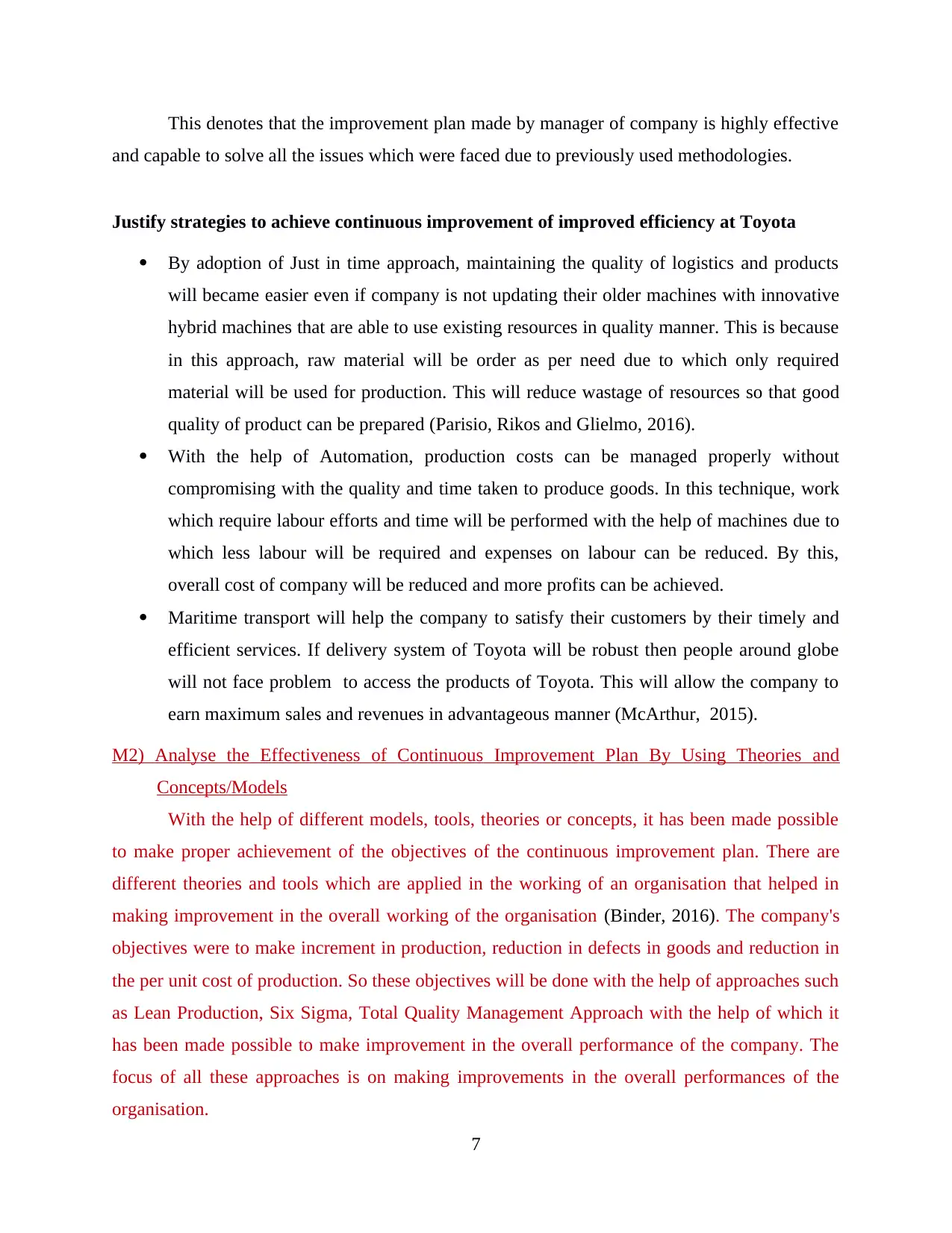
This denotes that the improvement plan made by manager of company is highly effective
and capable to solve all the issues which were faced due to previously used methodologies.
Justify strategies to achieve continuous improvement of improved efficiency at Toyota
By adoption of Just in time approach, maintaining the quality of logistics and products
will became easier even if company is not updating their older machines with innovative
hybrid machines that are able to use existing resources in quality manner. This is because
in this approach, raw material will be order as per need due to which only required
material will be used for production. This will reduce wastage of resources so that good
quality of product can be prepared (Parisio, Rikos and Glielmo, 2016).
With the help of Automation, production costs can be managed properly without
compromising with the quality and time taken to produce goods. In this technique, work
which require labour efforts and time will be performed with the help of machines due to
which less labour will be required and expenses on labour can be reduced. By this,
overall cost of company will be reduced and more profits can be achieved.
Maritime transport will help the company to satisfy their customers by their timely and
efficient services. If delivery system of Toyota will be robust then people around globe
will not face problem to access the products of Toyota. This will allow the company to
earn maximum sales and revenues in advantageous manner (McArthur, 2015).
M2) Analyse the Effectiveness of Continuous Improvement Plan By Using Theories and
Concepts/Models
With the help of different models, tools, theories or concepts, it has been made possible
to make proper achievement of the objectives of the continuous improvement plan. There are
different theories and tools which are applied in the working of an organisation that helped in
making improvement in the overall working of the organisation (Binder, 2016). The company's
objectives were to make increment in production, reduction in defects in goods and reduction in
the per unit cost of production. So these objectives will be done with the help of approaches such
as Lean Production, Six Sigma, Total Quality Management Approach with the help of which it
has been made possible to make improvement in the overall performance of the company. The
focus of all these approaches is on making improvements in the overall performances of the
organisation.
7
and capable to solve all the issues which were faced due to previously used methodologies.
Justify strategies to achieve continuous improvement of improved efficiency at Toyota
By adoption of Just in time approach, maintaining the quality of logistics and products
will became easier even if company is not updating their older machines with innovative
hybrid machines that are able to use existing resources in quality manner. This is because
in this approach, raw material will be order as per need due to which only required
material will be used for production. This will reduce wastage of resources so that good
quality of product can be prepared (Parisio, Rikos and Glielmo, 2016).
With the help of Automation, production costs can be managed properly without
compromising with the quality and time taken to produce goods. In this technique, work
which require labour efforts and time will be performed with the help of machines due to
which less labour will be required and expenses on labour can be reduced. By this,
overall cost of company will be reduced and more profits can be achieved.
Maritime transport will help the company to satisfy their customers by their timely and
efficient services. If delivery system of Toyota will be robust then people around globe
will not face problem to access the products of Toyota. This will allow the company to
earn maximum sales and revenues in advantageous manner (McArthur, 2015).
M2) Analyse the Effectiveness of Continuous Improvement Plan By Using Theories and
Concepts/Models
With the help of different models, tools, theories or concepts, it has been made possible
to make proper achievement of the objectives of the continuous improvement plan. There are
different theories and tools which are applied in the working of an organisation that helped in
making improvement in the overall working of the organisation (Binder, 2016). The company's
objectives were to make increment in production, reduction in defects in goods and reduction in
the per unit cost of production. So these objectives will be done with the help of approaches such
as Lean Production, Six Sigma, Total Quality Management Approach with the help of which it
has been made possible to make improvement in the overall performance of the company. The
focus of all these approaches is on making improvements in the overall performances of the
organisation.
7
⊘ This is a preview!⊘
Do you want full access?
Subscribe today to unlock all pages.

Trusted by 1+ million students worldwide
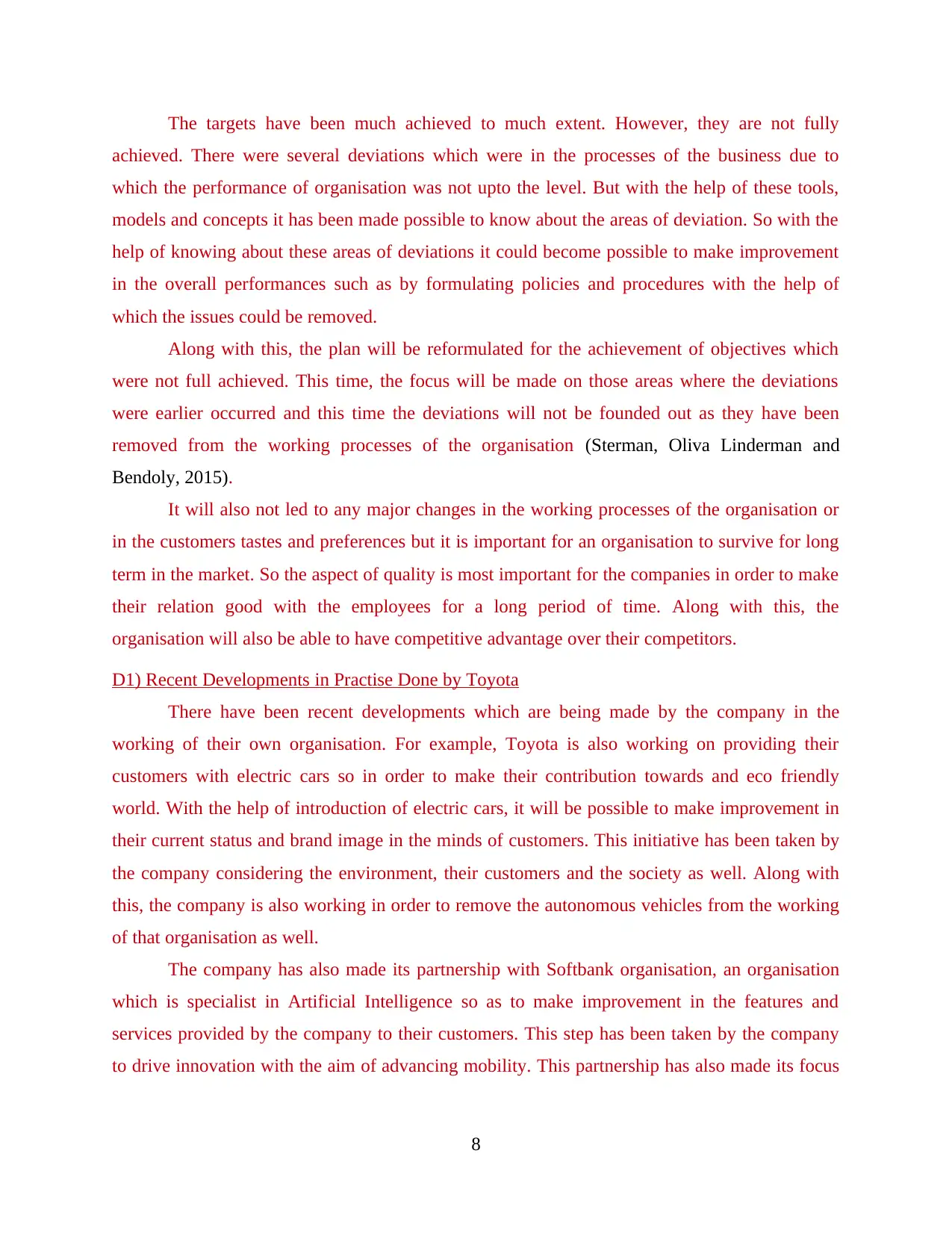
The targets have been much achieved to much extent. However, they are not fully
achieved. There were several deviations which were in the processes of the business due to
which the performance of organisation was not upto the level. But with the help of these tools,
models and concepts it has been made possible to know about the areas of deviation. So with the
help of knowing about these areas of deviations it could become possible to make improvement
in the overall performances such as by formulating policies and procedures with the help of
which the issues could be removed.
Along with this, the plan will be reformulated for the achievement of objectives which
were not full achieved. This time, the focus will be made on those areas where the deviations
were earlier occurred and this time the deviations will not be founded out as they have been
removed from the working processes of the organisation (Sterman, Oliva Linderman and
Bendoly, 2015).
It will also not led to any major changes in the working processes of the organisation or
in the customers tastes and preferences but it is important for an organisation to survive for long
term in the market. So the aspect of quality is most important for the companies in order to make
their relation good with the employees for a long period of time. Along with this, the
organisation will also be able to have competitive advantage over their competitors.
D1) Recent Developments in Practise Done by Toyota
There have been recent developments which are being made by the company in the
working of their own organisation. For example, Toyota is also working on providing their
customers with electric cars so in order to make their contribution towards and eco friendly
world. With the help of introduction of electric cars, it will be possible to make improvement in
their current status and brand image in the minds of customers. This initiative has been taken by
the company considering the environment, their customers and the society as well. Along with
this, the company is also working in order to remove the autonomous vehicles from the working
of that organisation as well.
The company has also made its partnership with Softbank organisation, an organisation
which is specialist in Artificial Intelligence so as to make improvement in the features and
services provided by the company to their customers. This step has been taken by the company
to drive innovation with the aim of advancing mobility. This partnership has also made its focus
8
achieved. There were several deviations which were in the processes of the business due to
which the performance of organisation was not upto the level. But with the help of these tools,
models and concepts it has been made possible to know about the areas of deviation. So with the
help of knowing about these areas of deviations it could become possible to make improvement
in the overall performances such as by formulating policies and procedures with the help of
which the issues could be removed.
Along with this, the plan will be reformulated for the achievement of objectives which
were not full achieved. This time, the focus will be made on those areas where the deviations
were earlier occurred and this time the deviations will not be founded out as they have been
removed from the working processes of the organisation (Sterman, Oliva Linderman and
Bendoly, 2015).
It will also not led to any major changes in the working processes of the organisation or
in the customers tastes and preferences but it is important for an organisation to survive for long
term in the market. So the aspect of quality is most important for the companies in order to make
their relation good with the employees for a long period of time. Along with this, the
organisation will also be able to have competitive advantage over their competitors.
D1) Recent Developments in Practise Done by Toyota
There have been recent developments which are being made by the company in the
working of their own organisation. For example, Toyota is also working on providing their
customers with electric cars so in order to make their contribution towards and eco friendly
world. With the help of introduction of electric cars, it will be possible to make improvement in
their current status and brand image in the minds of customers. This initiative has been taken by
the company considering the environment, their customers and the society as well. Along with
this, the company is also working in order to remove the autonomous vehicles from the working
of that organisation as well.
The company has also made its partnership with Softbank organisation, an organisation
which is specialist in Artificial Intelligence so as to make improvement in the features and
services provided by the company to their customers. This step has been taken by the company
to drive innovation with the aim of advancing mobility. This partnership has also made its focus
8
Paraphrase This Document
Need a fresh take? Get an instant paraphrase of this document with our AI Paraphraser
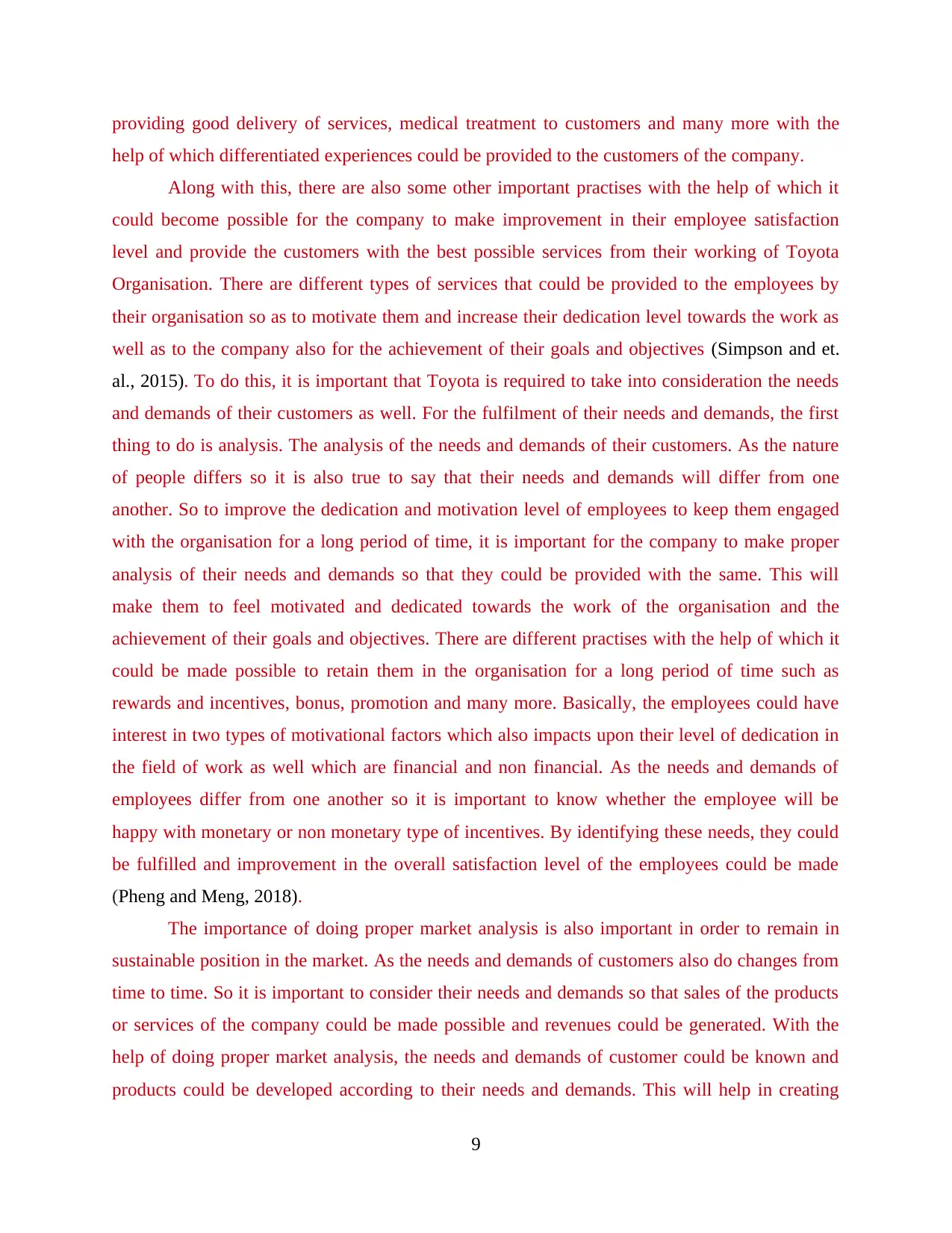
providing good delivery of services, medical treatment to customers and many more with the
help of which differentiated experiences could be provided to the customers of the company.
Along with this, there are also some other important practises with the help of which it
could become possible for the company to make improvement in their employee satisfaction
level and provide the customers with the best possible services from their working of Toyota
Organisation. There are different types of services that could be provided to the employees by
their organisation so as to motivate them and increase their dedication level towards the work as
well as to the company also for the achievement of their goals and objectives (Simpson and et.
al., 2015). To do this, it is important that Toyota is required to take into consideration the needs
and demands of their customers as well. For the fulfilment of their needs and demands, the first
thing to do is analysis. The analysis of the needs and demands of their customers. As the nature
of people differs so it is also true to say that their needs and demands will differ from one
another. So to improve the dedication and motivation level of employees to keep them engaged
with the organisation for a long period of time, it is important for the company to make proper
analysis of their needs and demands so that they could be provided with the same. This will
make them to feel motivated and dedicated towards the work of the organisation and the
achievement of their goals and objectives. There are different practises with the help of which it
could be made possible to retain them in the organisation for a long period of time such as
rewards and incentives, bonus, promotion and many more. Basically, the employees could have
interest in two types of motivational factors which also impacts upon their level of dedication in
the field of work as well which are financial and non financial. As the needs and demands of
employees differ from one another so it is important to know whether the employee will be
happy with monetary or non monetary type of incentives. By identifying these needs, they could
be fulfilled and improvement in the overall satisfaction level of the employees could be made
(Pheng and Meng, 2018).
The importance of doing proper market analysis is also important in order to remain in
sustainable position in the market. As the needs and demands of customers also do changes from
time to time. So it is important to consider their needs and demands so that sales of the products
or services of the company could be made possible and revenues could be generated. With the
help of doing proper market analysis, the needs and demands of customer could be known and
products could be developed according to their needs and demands. This will help in creating
9
help of which differentiated experiences could be provided to the customers of the company.
Along with this, there are also some other important practises with the help of which it
could become possible for the company to make improvement in their employee satisfaction
level and provide the customers with the best possible services from their working of Toyota
Organisation. There are different types of services that could be provided to the employees by
their organisation so as to motivate them and increase their dedication level towards the work as
well as to the company also for the achievement of their goals and objectives (Simpson and et.
al., 2015). To do this, it is important that Toyota is required to take into consideration the needs
and demands of their customers as well. For the fulfilment of their needs and demands, the first
thing to do is analysis. The analysis of the needs and demands of their customers. As the nature
of people differs so it is also true to say that their needs and demands will differ from one
another. So to improve the dedication and motivation level of employees to keep them engaged
with the organisation for a long period of time, it is important for the company to make proper
analysis of their needs and demands so that they could be provided with the same. This will
make them to feel motivated and dedicated towards the work of the organisation and the
achievement of their goals and objectives. There are different practises with the help of which it
could be made possible to retain them in the organisation for a long period of time such as
rewards and incentives, bonus, promotion and many more. Basically, the employees could have
interest in two types of motivational factors which also impacts upon their level of dedication in
the field of work as well which are financial and non financial. As the needs and demands of
employees differ from one another so it is important to know whether the employee will be
happy with monetary or non monetary type of incentives. By identifying these needs, they could
be fulfilled and improvement in the overall satisfaction level of the employees could be made
(Pheng and Meng, 2018).
The importance of doing proper market analysis is also important in order to remain in
sustainable position in the market. As the needs and demands of customers also do changes from
time to time. So it is important to consider their needs and demands so that sales of the products
or services of the company could be made possible and revenues could be generated. With the
help of doing proper market analysis, the needs and demands of customer could be known and
products could be developed according to their needs and demands. This will help in creating
9
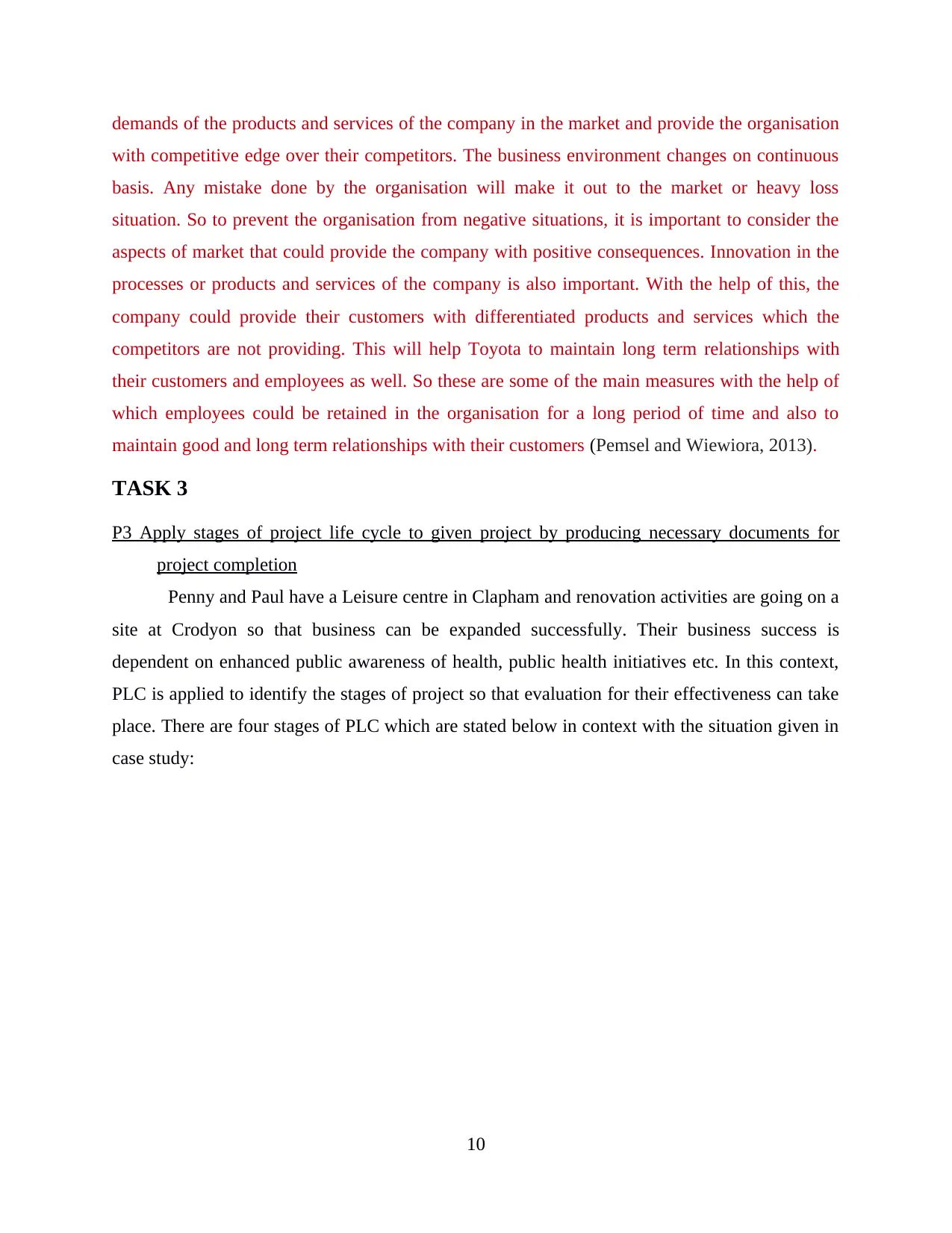
demands of the products and services of the company in the market and provide the organisation
with competitive edge over their competitors. The business environment changes on continuous
basis. Any mistake done by the organisation will make it out to the market or heavy loss
situation. So to prevent the organisation from negative situations, it is important to consider the
aspects of market that could provide the company with positive consequences. Innovation in the
processes or products and services of the company is also important. With the help of this, the
company could provide their customers with differentiated products and services which the
competitors are not providing. This will help Toyota to maintain long term relationships with
their customers and employees as well. So these are some of the main measures with the help of
which employees could be retained in the organisation for a long period of time and also to
maintain good and long term relationships with their customers (Pemsel and Wiewiora, 2013).
TASK 3
P3 Apply stages of project life cycle to given project by producing necessary documents for
project completion
Penny and Paul have a Leisure centre in Clapham and renovation activities are going on a
site at Crodyon so that business can be expanded successfully. Their business success is
dependent on enhanced public awareness of health, public health initiatives etc. In this context,
PLC is applied to identify the stages of project so that evaluation for their effectiveness can take
place. There are four stages of PLC which are stated below in context with the situation given in
case study:
10
with competitive edge over their competitors. The business environment changes on continuous
basis. Any mistake done by the organisation will make it out to the market or heavy loss
situation. So to prevent the organisation from negative situations, it is important to consider the
aspects of market that could provide the company with positive consequences. Innovation in the
processes or products and services of the company is also important. With the help of this, the
company could provide their customers with differentiated products and services which the
competitors are not providing. This will help Toyota to maintain long term relationships with
their customers and employees as well. So these are some of the main measures with the help of
which employees could be retained in the organisation for a long period of time and also to
maintain good and long term relationships with their customers (Pemsel and Wiewiora, 2013).
TASK 3
P3 Apply stages of project life cycle to given project by producing necessary documents for
project completion
Penny and Paul have a Leisure centre in Clapham and renovation activities are going on a
site at Crodyon so that business can be expanded successfully. Their business success is
dependent on enhanced public awareness of health, public health initiatives etc. In this context,
PLC is applied to identify the stages of project so that evaluation for their effectiveness can take
place. There are four stages of PLC which are stated below in context with the situation given in
case study:
10
⊘ This is a preview!⊘
Do you want full access?
Subscribe today to unlock all pages.

Trusted by 1+ million students worldwide
1 out of 28
Related Documents
Your All-in-One AI-Powered Toolkit for Academic Success.
+13062052269
info@desklib.com
Available 24*7 on WhatsApp / Email
![[object Object]](/_next/static/media/star-bottom.7253800d.svg)
Unlock your academic potential
Copyright © 2020–2025 A2Z Services. All Rights Reserved. Developed and managed by ZUCOL.




